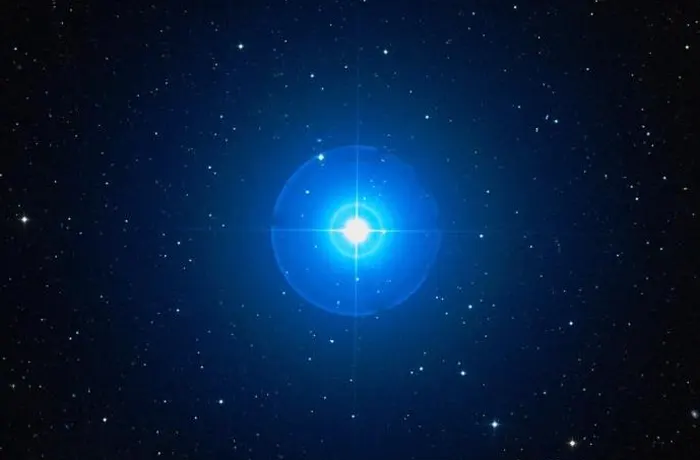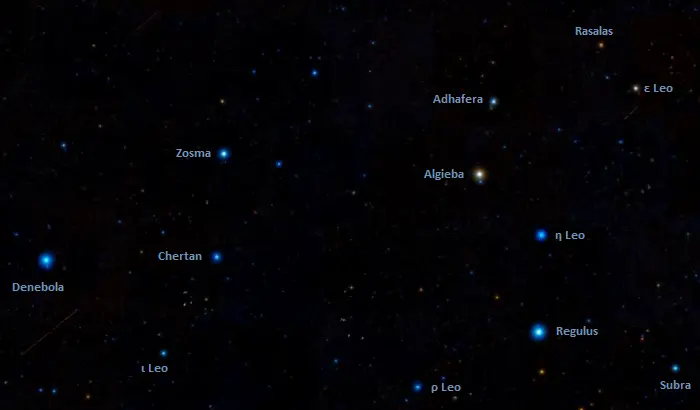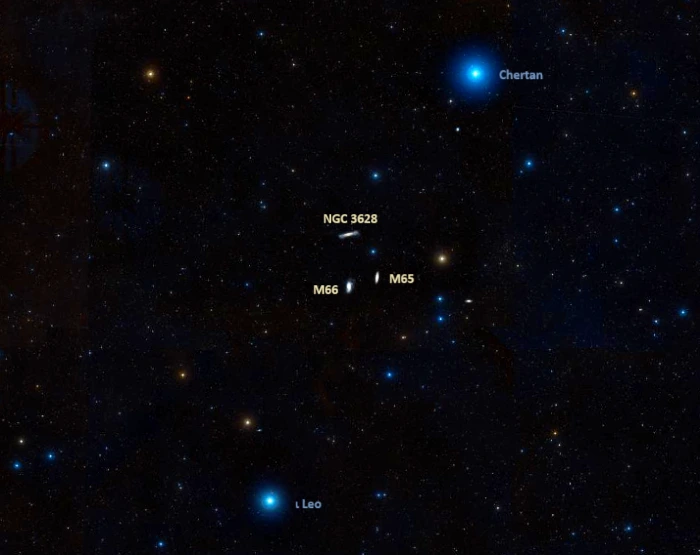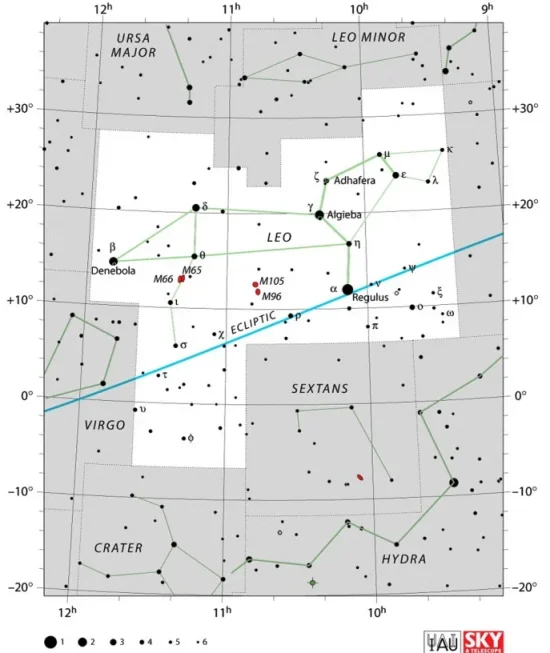Chertan, Theta Leonis (θ Leo) is a white main sequence star located approximately 165 light years away in the constellation Leo. With an apparent magnitude of 3.324, it is the sixth brightest star in Leo. It marks the celestial Lion’s hip.
Star type
Chertan is a white main sequence star of the spectral type A2 V. It has a mass 2.8 times that of the Sun and a radius of 4.03 solar radii. With an effective temperature of 9,480 K, it is about 118 times more luminous than the Sun. The star has an estimated age of around 407 million years. Some sources classify it as a subgiant star with the spectral class A2 IV.
Theta Leonis is a chemically peculiar star with enhanced absorption lines of metals. It is classified as an Am star (metallic-line star). Even though it is much younger than the Sun, it has 12 percent higher metallicity. The star has an underabundance of calcium and scandium and is enhanced in the heavier elements, including iron, strontium and barium.
Chertan has a projected rotational velocity of 23 km/s. However, astronomers believe that its true spin rate is much higher. Interferometric observations with the CHARA array indicate that, like the bright Vega, Chertan appears almost pole-on from our point of view.
Observations in the infrared band have revealed an excess infrared emission from the star. This suggests the presence of an orbiting circumstellar disk. The disk of dust orbits the star at a separation of 36 astronomical units (AU).

Chertan (Theta Leonis), image credit: ESO/Digitized Sky Survey 2 (CC BY 4.0)
Facts
Chertan is the sixth brightest star in Leo, after Regulus (Alpha Leonis), Algieba (Gamma Leonis), Denebola (Beta Leonis), Zosma (Delta Leonis), and Epsilon Leonis. It forms the constellation figure of the Lion with these stars and the fainter Adhafera (Zeta Leonis), Rasalas (Mu Leonis), and Eta Leonis.
Chertan is, on average, the 243rd brightest star in the sky. It is about as bright as Tau Sagittarii in the constellation Sagittarius, Rhombus (Alpha Reticuli) in Reticulum, Azmidi (Xi Puppis) in Puppis, and Segin (Epsilon Cassiopeiae) in Cassiopeia.
In ancient Mesopotamia, Chertan and Zosma formed the constellation of the god Kua (the Oracle), called Kakkab Kua.
The Egyptians called the two stars Mes-su (“the anointed one”). In Persian astronomy, Chertan and Zosma were known as Al Haratan, and in India they were called Purva Phalguni.

Leo stars, image: ESO/Digitized Sky Survey 2 (CC BY 4.0)
Name
The name Chertan comes from the Arabic al-khurtan (al-kharātān), meaning “the two small ribs (at or near the breast).” The name originally applied to both Theta Leonis and Delta Leonis, now formally known as Zosma.
Theta Leonis was also historically called Chort and Coxa. Chort is derived from the Arabic al-kharāt or al-khurt, meaning “small rib,” and Coxa is the Latin word for “hip.”
The International Astronomical Union’s (IAU) Working Group on Star Names (WGSN) approved the name Chertan for Theta Leonis on July 20, 2026.
In Chinese astronomy Chertan was known as 太微右垣四 (Tài Wēi Zuǒ Yuán sì), the Fourth Star of Right Wall of Supreme Palace Enclosure. It formed the asterism known as the Right Wall of Supreme Palace Enclosure with Zavijava (Beta Virginis), Sigma Leonis, Iota Leonis, and Zosma (Delta Leonis). Theta Leonis represented the Second Western Minister (西次相,Xīcìxiāng).
Location
Chertan is part of the conspicuous constellation figure of Leo. It marks the celestial Lion’s back hip.
Leo can be found using the stars of the Big Dipper. A line drawn from the inner stars of the Dipper’s bowl leads towards Regulus, the brightest star in Leo. Regulus marks the Lion’s heart and sits at base of the Sickle, an asterism that forms the Lion’s head, mane, and shoulders. The bright Denebola marks the Lion’s tail, and Chertan is the brightest point of light between Denebola and Regulus.

The location of Chertan (Theta Leonis), image: Stellarium
Chertan and the fainter Iota Leonis can be used to find the Leo Triplet of galaxies. Also known as the Messier 66 Group, the Leo Triplet consists of the spiral galaxies Messier 65, Messier 66, and the Hamburger Galaxy (NGC 3628). Messier 65 appears roughly halfway between Theta and Iota Leonis and the other two galaxies lie in the same wide field of view. The Leo Triplet can be observed in small telescopes in good conditions.

Chertan, Iota Leonis and the Leo Triplet, image credit: ESO/Digitized Sky Survey 2 (CC BY 4.0)
Constellation
Chertan is located in the constellation Leo. Leo is one of the 12 zodiac constellations, which lie on the ecliptic, as well as one of the 15 equatorial constellations, which lie on the celestial equator. The constellation is visible from both hemispheres for at least part of the year.
The Lion is one of the Greek constellations, listed by the Greco-Roman astronomer Claudius Ptolemy of Alexandria in his Almagest in the 2nd century CE. In Greek mythology, it represents the Nemean Lion, a mythical monster defeated by Heracles as part of his 12 labours.
Leo stretches across 947 square degrees of the sky and is the fifth largest northern constellation and the 12th largest of all 88 constellations.
Leo contains five stars brighter than magnitude 3.0, including Regulus, one of the brightest stars in the sky. The constellation is relatively easy to spot in good conditions because it looks like the animal it represents. Several of its bright stars form the Sickle, an asterism that represents the Lion’s head and mane.

Leo constellation map by IAU and Sky&Telescope magazine (Roger Sinnott & Rick Fienberg) (CC BY 3.0)
Notable stars in Leo include the fast-spinning B-type subgiant Regulus (Alpha Leonis) and A-type stars Denebola (Beta Leonis) and Zosma (Delta Leonis), the variable orange giant Algieba (Gamma Leonis), the yellow bright giant Epsilon Leonis, the yellow-white giant Adhafera (Zeta Leonis), the blue-white supergiant Eta Leonis, the variable blue supergiant Shaomin (Rho Leonis), and the orange giants Rasalas (Mu Leonis) and Alterf (Lambda Leonis).
Leo is also home to Caffau’s Star (SDSS J102915+172927), one of the oldest known stars in the Milky Way, the carbon star CW Leonis, the red dwarf Wolf 359, one of the closest stars to the Sun, and Icarus (MACS J1149 LS1), one of the most distant stars known.
In addition to the Leo Triplet, deep sky objects in Leo include the Leo I Group, consisting of the bright galaxies Messier 95, Messier 96 and Messier 105, the colliding galaxies NGC 3226 and NGC 3227, the Frosty Leo Nebula, the Owl Galaxy (NGC 3758), the Silverado Galaxy (NGC 3370), and the gravitationally lensed system of two galaxies known as the Cosmic Horseshoe.
The best time of the year to see the stars and deep sky objects in Leo is during the month of April, when the constellation appears higher above the horizon in the early evening. The entire constellation can be seen from locations north of the latitude 65° S.
The 10 brightest stars in Leo are Regulus (Alpha Leo, mag. 1.40), Algieba (Gamma Leo, mag. 2.08), Denebola (Beta Leo, mag. 2.113), Zosma (Delta Leo, mag. 2.56), Epsilon Leonis (mag. 2.98), Chertan (Theta Leo, mag. 3.324), Adhafera (Zeta Leo, mag. 3.33), Eta Leonis (mag. 3.486), Subra (Omicron Leo, mag. 3.52), and Shaomin (Rho Leo, mag. 3.9).
Chertan – Theta Leonis
| Spectral class | A2 V or A2 IV |
| U-B colour index | +0.07 |
| B-V colour index | -0.02 |
| Apparent magnitude | 3.324 |
| Absolute magnitude | -0.19 |
| Distance | 165 ± 1 light-years (50.6 ± 0.4 parsecs) |
| Parallax | 20.3160 ± 0.3262 mas |
| Radial velocity | +7.536 ± 0.0257 km/s |
| Proper motion | RA: – 60.538 ± 0.374 mas/yr |
| Dec.: -78.675 ± 0.321 mas/yr | |
| Mass | 2.8 ± 0.1 M☉ |
| Luminosity | 118 ± 5 L☉ |
| Radius | 4.03 ± 0.10 R☉ |
| Temperature | 9,480 ± 120 K |
| Metallicity | +0.05 dex |
| Age | 407±12 million years |
| Rotational velocity | 23 km/s |
| Surface gravity | 3.65 cgs |
| Constellation | Leo |
| Right ascension | 11h 14m 14.4056705348s |
| Declination | +15° 25′ 46.455911128″ |
| Names and designations | Chertan, Theta Leonis, θ Leonis, θ Leo, 70 Leonis, 70 Leo, Chort, Coxa, HD 97633, HR 4359, HIP 54879, SAO 99512, FK5 423, PPM 128087, SKY# 21410, BD+16 2234, AG+15 1219, GC 15441, GCRV 6894, PLX 2615.00, PMC 90-93 305, GSC 01437-02847, GEN# +1.00097633, JP11 2040, N30 2638, NSV 5144, Renson 28150, ROT 1672, SRS 30423, 2MASS J11141442+1525466, TD1 15476, uvby98 100097633, UBV 10244, UBV M 16907, WEB 9905, TIC 77172923, TYC 1437-2847-1, Gaia DR2 3970052886914307200, Gaia DR3 3970052886914547712 |